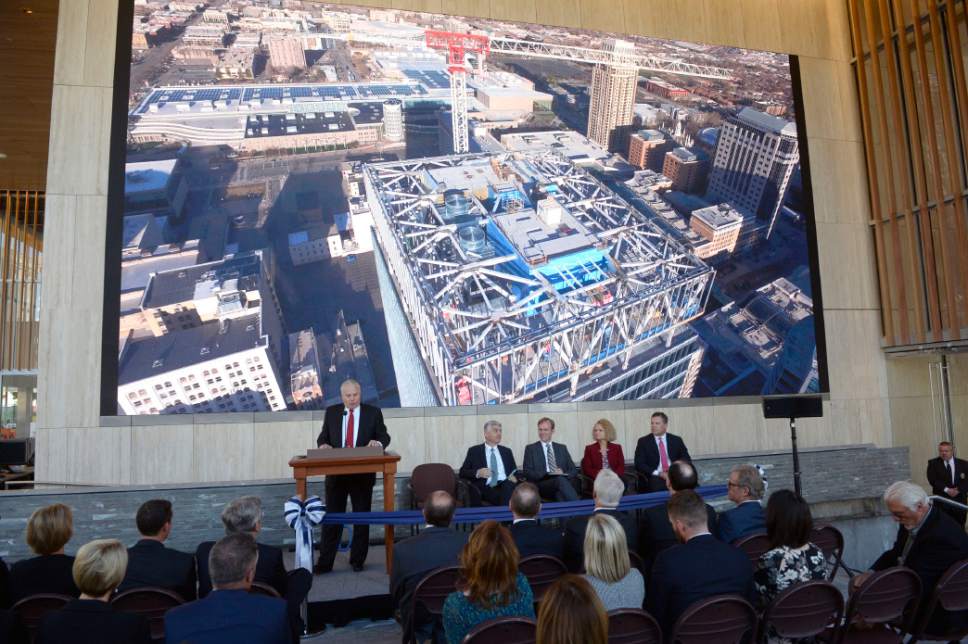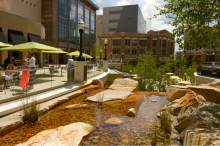This is an archived article that was published on sltrib.com in 2017, and information in the article may be outdated. It is provided only for personal research purposes and may not be reprinted.
By the time a child turns 5, the parents are starting to get an idea of the human being that child is becoming.
It's the same, in a way, with a shopping center — and the many parents and guardians of City Creek Center, the downtown Salt Lake City destination that marks its fifth birthday on Wednesday, are beaming with pride about how their kid is growing up.
"Wow — I can't say anything but wow," Lane Beattie, president and CEO of the Salt Lake Chamber, said at a pre-celebratory gathering of officials this week.
City Creek, said Natalie Gochnour, director of the University of Utah's Kem C. Gardner Policy Institute, "made downtown the heart of our city."
Mark Gibbons, president of City Creek Reserve Inc., the LDS Church-owned company that operates the shopping-and-residential development, said City Creek Center was built with two goals in mind — and the results have far exceeded those goals.
One goal was to revitalize Main Street, which Gibbons noted was evident by the increased foot traffic downtown. "There are now thousands of people in this city every day," he said. "They enjoy being here."
(This goal coincides with an unspoken wish of The Church of Jesus Christ of Latter-day Saints: to provide a buffer zone around Temple Square, so visitors to the LDS Church's most sacred locations don't wind up someplace skeevy when they cross the street.)
The second goal, Gibbons said, was to create "a catalyst for development." In other words, to paraphrase an old movie quote: if you build it, they will come.
City Creek Center, Gibbons and others believe, has sparked a resurgence on Salt Lake City's Main Street. Examples of this include the opening of the 222 Main building (finished in 2009, while City Creek was under construction), the remodeling of Gallivan Center (completed in 2011) and last fall's opening of the Eccles Theater and its adjacent office building, 111 Main. (This gathering of officials took place on the 22nd floor of 111 Main, in the conference room of CBC Advisors, overlooking City Creek.)
Scott Beck, president and CEO of Visit Salt Lake, touted City Creek and the subsequent development as a motivator for the city's "Ski City USA" branding campaign — an effort to encourage skiers to enjoy Salt Lake's urban pleasures after a day on the slopes.
"[Skiers] think about hot tubs and beer [after skiing]. They don't think about ballet and theater," Beck said. "City Creek epitomizes the city experience."
It's not the complete city experience, though. Even with the Eccles Theater bringing in touring Broadway shows and concerts, nightlife is a hard sell at City Creek, where only one restaurant (The Cheesecake Factory) stays open past 9:30 p.m., and there aren't any bars.
That may change soon, with the development of Regent Street. One restaurant, a pizza place, has already opened there, and more are on the way. The street, once home to Salt Lake Tribune delivery trucks picking up bundles of the morning paper, will make a charming boulevard linking City Creek, the Eccles and the Gallivan Center.
Sitting in on this happy celebration of City Creek, I felt, as somebody who works at The Tribune, like the ex-wife who got invited to her husband's second wedding.
Before 2005, the Tribune's offices were in the heart of Main Street. Then, our owners moved us to The Gateway, which had been open for less than four years, making it the new shiny object that City Creek is now. The Gateway also had (and still has) entertainment destinations: the Megaplex 12 movie theaters, the Clark Planetarium and the Discovery Gateway children's museum.
When City Creek was going up, a fair number of Gateway tenants — including The Gap, Anthropologie and the Apple store — decided they wanted to be a part of it. Players gonna play, capitalists gonna capitalize, and all that.
Adding to The Gateway's problems were the neighbors: the growing homeless population in the Rio Grande area. The homeless would migrate north through The Gateway, making it a less hospitable place for shoppers, diners, moviegoers and folks parking to go to a Jazz game.
The Gateway recently was taken over by a new company, Vestar, which is working to reverse that center's sagging fortunes. (Vestar also runs the Valley Fair mall, which has been looking better and better the past few years.) More Gateway tenants have left — we even lost our main Starbucks — but crews can be seen remaking the parking garage and preparing spaces for new tenants. It feels like the place is turning a corner.
Those assembled to celebrate City Creek's birthday are bullish on The Gateway, too.
Lara Fritts, recently hired as director of the city's Department of Economic Development, said growth emanating from City Creek will ultimately spread west toward The Gateway. She pointed to plans to renovate the plaza outside Vivint Smart Home Arena as one of the pieces in that puzzle.
And Reid Ewing, director of the U.'s Metropolitan Research Center, said that eventually downtown Salt Lake City will become one continuous urban core, spanning The Gateway and City Creek.
That was the hopeful message on City Creek's fifth birthday: The center and the city still have a lot of growing to do.
Sean P. Means writes The Cricket in daily blog form at http://www.sltrib.com/blogs/moviecricket. Follow him on Twitter @moviecricket. Email him at spmeans@sltrib.com.







